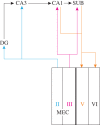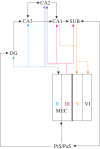Architecture of spatial circuits in the hippocampal region
- PMID: 24366129
- PMCID: PMC3866439
- DOI: 10.1098/rstb.2012.0515
Architecture of spatial circuits in the hippocampal region
Abstract
The hippocampal region contains several principal neuron types, some of which show distinct spatial firing patterns. The region is also known for its diversity in neural circuits and many have attempted to causally relate network architecture within and between these unique circuits to functional outcome. Still, much is unknown about the mechanisms or network properties by which the functionally specific spatial firing profiles of neurons are generated, let alone how they are integrated into a coherently functioning meta-network. In this review, we explore the architecture of local networks and address how they may interact within the context of an overarching space circuit, aiming to provide directions for future successful explorations.
Keywords: development; entorhinal cortex; hippocampus; parasubiculum; presubiculum.
Figures




References
-
- Ranck JB. 1985. Head direction cells in the deep cell layer of dorsal presubiculum in freely moving rats. In Electrical activity of the archicortex (eds Buzsaki G, Vanderwolf CH.), pp. 217–220. Budapest, Hungary: Akademiai Kiado.
Publication types
MeSH terms
LinkOut - more resources
Full Text Sources
Other Literature Sources

